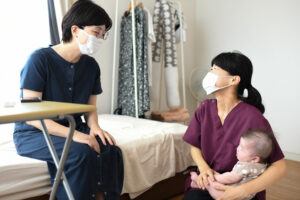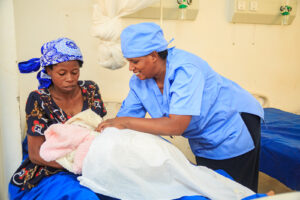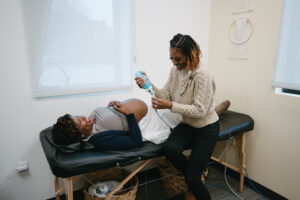Midwifery Models of Care – the way forward

The Midwifery Accelerator: expanding health care for women is the result of a global collaboration between UN health agencies, the ICM and other key partners. It is a ‘unified, evidence-driven global initiative aimed at significantly improving maternal and newborn health outcomes by scaling up midwifery models of care globally’.
 At the launch of the Midwifery Accelerator on April 7, 2025 HRH Sarah Zeid, Princess of Jordan opened the session with an impactful speech and call to action. Princess Sarah aptly described the recent political shifts and events that have had negatively impacted global humanitarian funding; “prospects for women and girls around the world are worse than ever and we are in crisis. The multi-lateral system is in tatters. The already inadequate development and humanitarian architecture is crumbling. International laws are brazenly being violated and violence and lies are going unchecked”.
At the launch of the Midwifery Accelerator on April 7, 2025 HRH Sarah Zeid, Princess of Jordan opened the session with an impactful speech and call to action. Princess Sarah aptly described the recent political shifts and events that have had negatively impacted global humanitarian funding; “prospects for women and girls around the world are worse than ever and we are in crisis. The multi-lateral system is in tatters. The already inadequate development and humanitarian architecture is crumbling. International laws are brazenly being violated and violence and lies are going unchecked”.
Princess Sarah went on to state four impactful irrefutable facts that must be acknowledged and actioned if we are to reduce maternal and newborn mortality and morbidity and reach the Sustainable Development Goals for health and well-being (SDG 3) and gender equality (SDG 5) by 2030.
She stated:
- “The health, well-being, education and equal participation in the workplace and society at large of women and girls are the keystone for family, community and national peace and prosperity.”
- “No matter the surrounding calm or chaos, people have sex, women and girls get pregnant and babies are born.”
- “The majority of stillbirths, maternal, newborn deaths and injury are preventable. It’s a fact. We know what must be done so that every pregnancy is wanted, every pregnancy and delivery are healthy and supported and every mother and caregiver equipped with the information and resources they need to give their children the building blocks for optimal cognitive, emotional and physical growth.”
- “If we, a global coalition of shared belief and ambition do not act with urgency, courage and principle, if we are unwilling to center our work on the needs of others and not our ideologies, priorities and timelines. If we are not prepared to consistently use our voices, access and leverage to defend and enable midwives, frontline workers and reproductive services; women, girls and their newborn babies will continue to die and in even greater numbers.”
 Centering our work on the Sexual and Reproductive Health (SRH) need of women, girls and gender diverse people demands investment in innovative, sustainable systems and optimal utilisation of resources, particularly in humanitarian and fragile settings where we know that most maternal and newborn mortality occurs.
Centering our work on the Sexual and Reproductive Health (SRH) need of women, girls and gender diverse people demands investment in innovative, sustainable systems and optimal utilisation of resources, particularly in humanitarian and fragile settings where we know that most maternal and newborn mortality occurs.
Midwives educated and regulated to global standards, and enabled and supported to work to full scope of practice have the potential to provide 90 % of essential sexual, reproductive, maternal, newborn and adolescent health (SRMNAH) services. Universal coverage of midwife-delivered interventions could avert 67% of maternal deaths, 64% of neonatal deaths, and 65% of stillbirths, allowing 4·3 million lives to be saved annually by 2035 . Despite the evidence being clear, challenges persist. To meet the need for improved SRMNAH outcomes by 2030 pre-pandemic estimations revealed the need for an additional 900,000 midwives. Post-pandemic estimations are likely to place the need as much higher.
Despite the challenges faced by humanitarian agencies and non-profit organisations, 2024 and early 2025 have seen significant progress in efforts to strengthen the midwifery profession.
The Midwifery Accelerator builds on the momentum created by the launch of the WHO Transitioning to Midwifery Models of Care in October 2024 and echoes the call to invest in Midwifery Models of Care as a smart, cost effective, human-rights based approach to improving health outcomes globally.
Midwifery Models of Care* (MMoC) is an umbrella term for the provision of care by educated, licensed, regulated midwives who coordinate their work across different settings and contexts. Midwives work in primary care in the community, in women’s homes and in secondary and tertiary levels of care. The common denominators of midwifery models of care are that the care is coordinated and provided by autonomous midwives working in a supported, integrated and collaborative environment. The guiding principles of the midwifery model are that the woman’s needs and preferences are met in a person-centered and respectful manner, centered on a trusting and reciprocal partnership between her/them and the midwife.
Midwives provide high quality care across the sexual and reproductive life course; contraception, safe abortion care (induced abortion and related to pregnancy loss), pre-pregnancy care, continuing all the way through the postnatal period caring for both mother and newborn.
Midwifery care optimizes physiological, biological, psychological, social and cultural processes, using interventions only when indicated. All women need midwives, and some of these also need doctors and for this reason midwives do not work alone. They belong to networks of care, working in interdisciplinary teams for the provision of SRMNAH, consulting and referring, when women’s needs become complex, and intervention may be required .
The Midwifery Accelerator provides a strong foundation for implementing Midwifery Models of Care, offering a shared, evidence-based roadmap to expand access to high-quality, respectful, and person-centred care. It is built around three pillars of action, each representing a key area for the creation of sustainable change to maternity services:
- Commit and Invest
- Educate, Deploy and Retain
- Advocate and Empower
 Across these three pillars, the Midwifery Accelerator outlines seven strategic priorities (“accelerators”), giving governments and partners a clear set of high-level actions to align efforts, amplify impact, and scale up midwifery coverage and increase system capacity for the achievement of universal health coverage goals.
Across these three pillars, the Midwifery Accelerator outlines seven strategic priorities (“accelerators”), giving governments and partners a clear set of high-level actions to align efforts, amplify impact, and scale up midwifery coverage and increase system capacity for the achievement of universal health coverage goals.
The Accelerator marks a significant step forward in the recognition of the midwifery profession and Midwifery Models of Care as central to achieving health and gender equity goals. It clearly demonstrates the essential link between high-level policy and regulatory frameworks, domestic and global investment, and quality midwifery education, professional development, and deployment. At the individual level, it underscores the importance of creating safe, supportive and accountable workplaces, where midwives can achieve job satisfaction and thrive, and, crucially, remain in the profession. It also makes the case for establishing clear career pathways, enabling midwives to take on leadership roles, strengthen their profession, drive advocacy efforts, and advance gender equity for women, girls and midwives themselves.
Together, the WHO Global Position Statement on Transitioning to Midwifery Models of Care and the Midwifery Accelerator provide a substantial and long-awaited boost in recognition for the midwifery profession and women’s right to respectful care. Much work remains, but there is no longer any question that midwives are an essential component of cost-effective, high-quality investments in efforts to improve maternal and newborn health outcomes.
This article is the first of a series of three. In the next article we will further explore Midwifery Models of Care by examining the accompanying Implementation guide which is due to be launched soon. In the third article, we will explore different forms of Midwifery Models of Care and highlight the need for all countries to respond to the call to action by implementing innovative models that answer the challenges relevant to their context, strengthen the midwifery profession and expand choice for women.
*Definition: Midwifery Models of Care are models in which the main care providers for women and newborns, starting from pre-pregnancy and continuing all the way through the postnatal period, are educated, licensed, regulated midwives who autonomously provide and coordinate respectful, high-quality care across their full scope of practice, using an approach that is aligned with the midwifery philosophy of care.